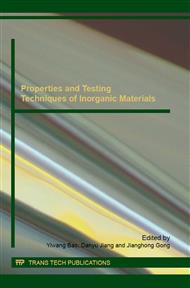[1]
S.L. Gu, Y.S. Zhang, A.J. Yang, Refractories selection for regenerator checker of floating glass furnace, Journal of Luoyang Technology College 10(4) (2000)17-18.
Google Scholar
[2]
P.M. Velasco, M.P.M. Ortiz, M.A.M. Giró, et al, Development of sustainable fired clay bricks by adding kindling from vine shoot: study of thermal and mechanical properties, Applied Clay Science 107(2015)156-164.
DOI: 10.1016/j.clay.2015.01.017
Google Scholar
[3]
A.A. Kadir, A. Mohajerani, Effect of heating rate on gas emissions and properties of fired clay bricks and fired clay bricks incorporated with cigarette butts, Applied Clay Science 104(2015)269-276.
DOI: 10.1016/j.clay.2014.12.005
Google Scholar
[4]
M. Sutcu, H. Alptekin, E. Erdogmus, et al, Characteristics of fired clay bricks with waste marble powder addition as building materials, Construction and Building Materials 82(2015)1-8.
DOI: 10.1016/j.conbuildmat.2015.02.055
Google Scholar
[5]
P. Pilate, V. Lardot, F. Cambier, et al, Contribution to the understanding of the high temperature behavior and of the compressive creep behavior of silica refractory materials, Journal of the European Ceramic Society 35(2015)813-822.
DOI: 10.1016/j.jeurceramsoc.2014.09.019
Google Scholar
[6]
A.G.T. Martinez, A.P. Luz, M.A.L. Braulio, et al, Creep behavior modeling of silica fume containing Al2O3-MgO refractory castables, Ceramics International 38(2012)327-332.
DOI: 10.1016/j.ceramint.2011.07.010
Google Scholar
[7]
A.R. D Arellano-López, J.J. Meléndez-Martínez, T.A. Cruse, et al, Compressive creep of mullite containing Y2O3, Acta Materialia 20(2002)4325-4338.
DOI: 10.1016/s1359-6454(02)00264-1
Google Scholar
[8]
L.A. Díaz, R. Torrecillas, Hot bending strength and creep behaviour at 1000-1400°C of high alumina refractory castables with spinel, periclase and dolomite additions, Journal of the European Ceramic Society 29(2009)53-58.
DOI: 10.1016/j.jeurceramsoc.2008.05.044
Google Scholar
[9]
Z.W. Xu, Y.B. Luo, Mechanism of damage of middle and lower course low-porosity clay checker brick in glass tank regenerators, Journal of Xi'an Institute of Metallurgy and Construction Engineering 1(1986)67-81.
Google Scholar
[10]
GB/T 21114-2007, Chemical analysis of refractory products by XRF-Fused cast bead method.
DOI: 10.3403/02815281
Google Scholar
[11]
GB/T 2997-2000, Test method for bulk density, apparent porosity and true porosity of dense shaped refractory products.
DOI: 10.3403/30347806
Google Scholar
[12]
YB/T 370-1995, Test method for refractoriness under load of refractory products (non-differential, with rising temperature).
DOI: 10.3403/30159046u
Google Scholar
[13]
GB/T 5073-2005, Refractory products – Test method of creep in compression.
Google Scholar
[14]
M. Hamidouche, M.A. Madjoubi, K. Loucif, et al, Processing and characterization of refractory made of Algerian kaolin, in: Proceedings of the Eighth Conference on Ceramics, 3-5 Sep., (2002).
Google Scholar
[15]
Y.Q. Liu, Silicate ceramic phase diagram, Chemical Industry Press, (2011).
Google Scholar


